Ostriches are surprising animals. Far from hiding their heads under the sand, they are courageous animals and know how to defend themselves. Conversely, it is true that they swallow stones to facilitate their digestion. In South Africa ostriches are battery farmed. In the farms of the Klein Karoo area of South Africa, there are over 90.000 ostriches which provide 120 tons of feathers every year.
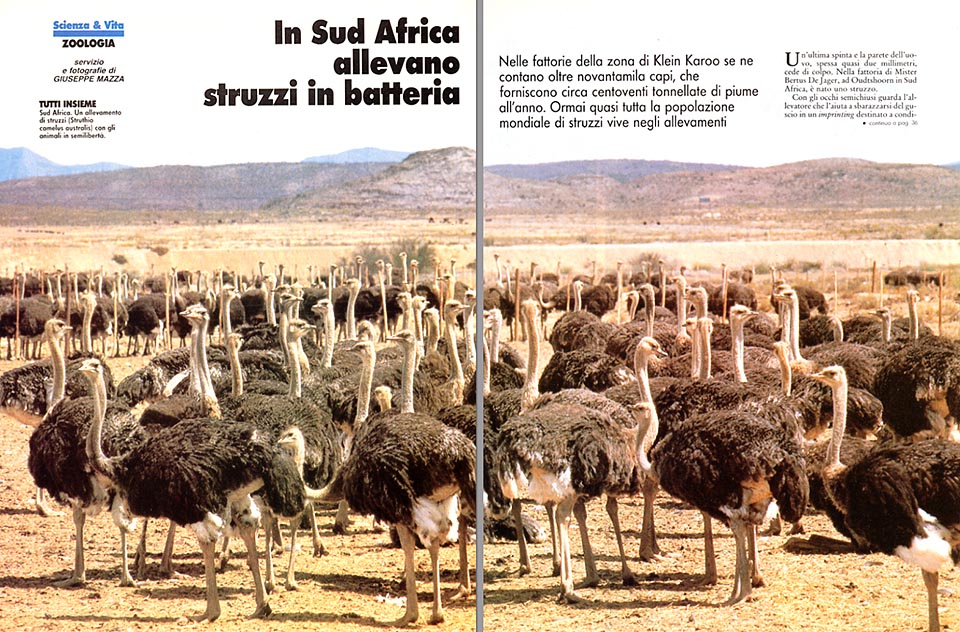
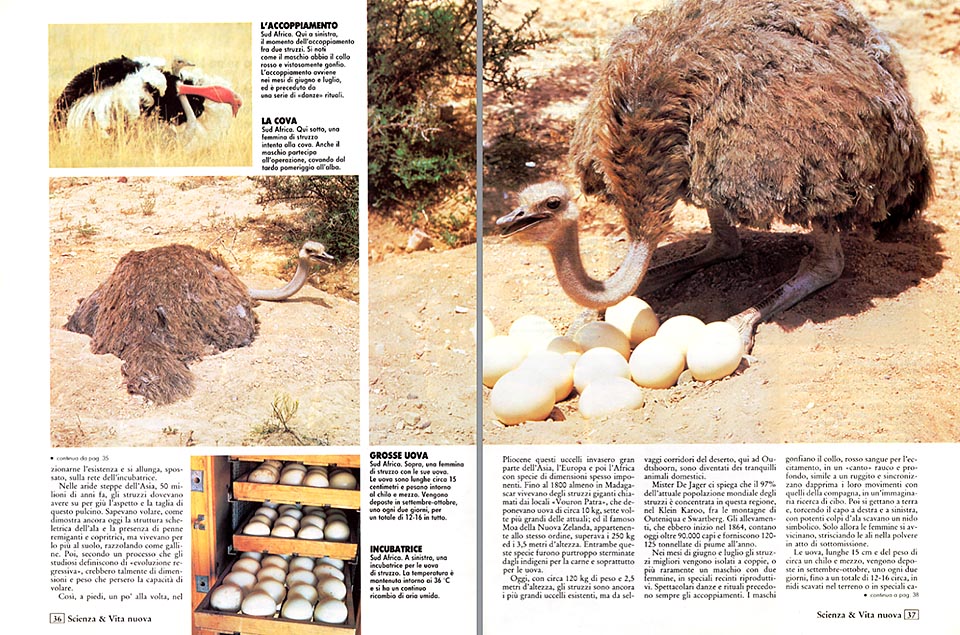
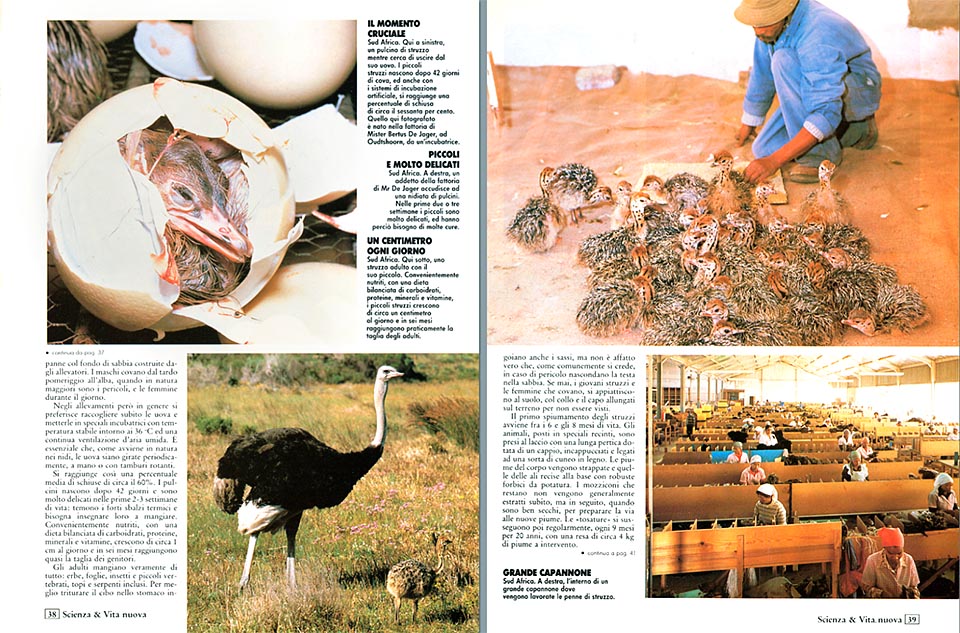
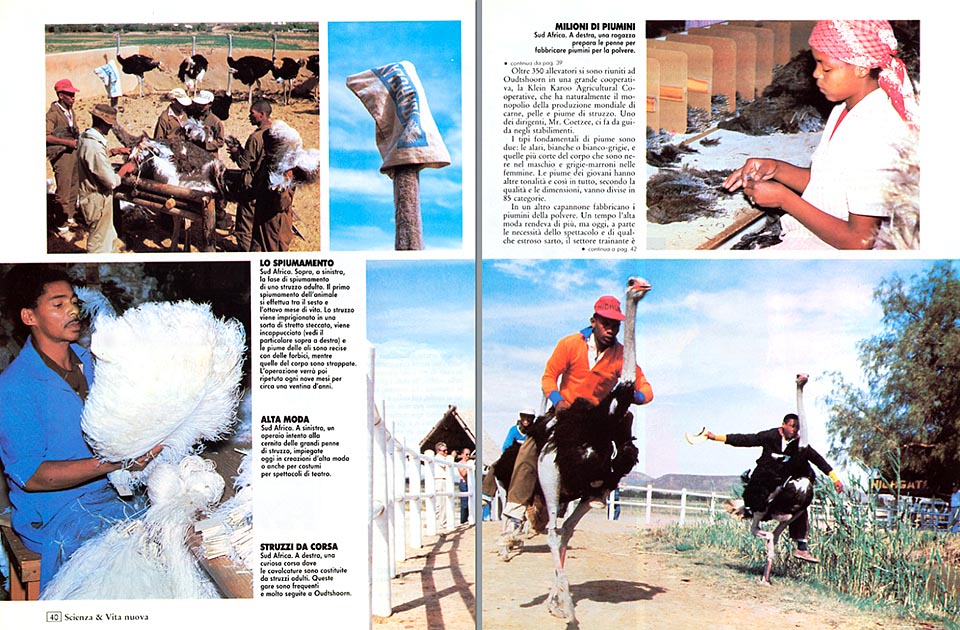
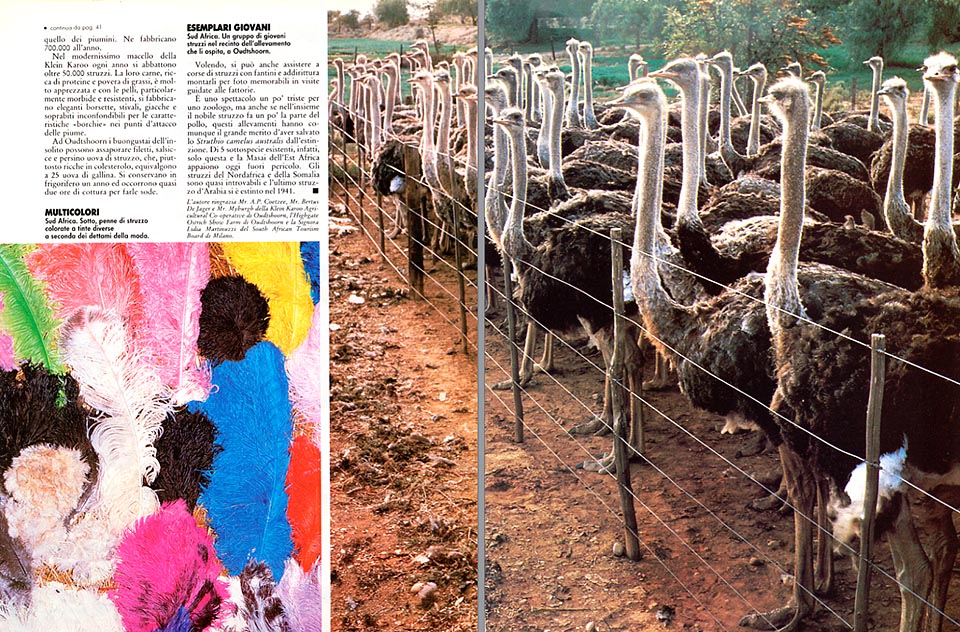
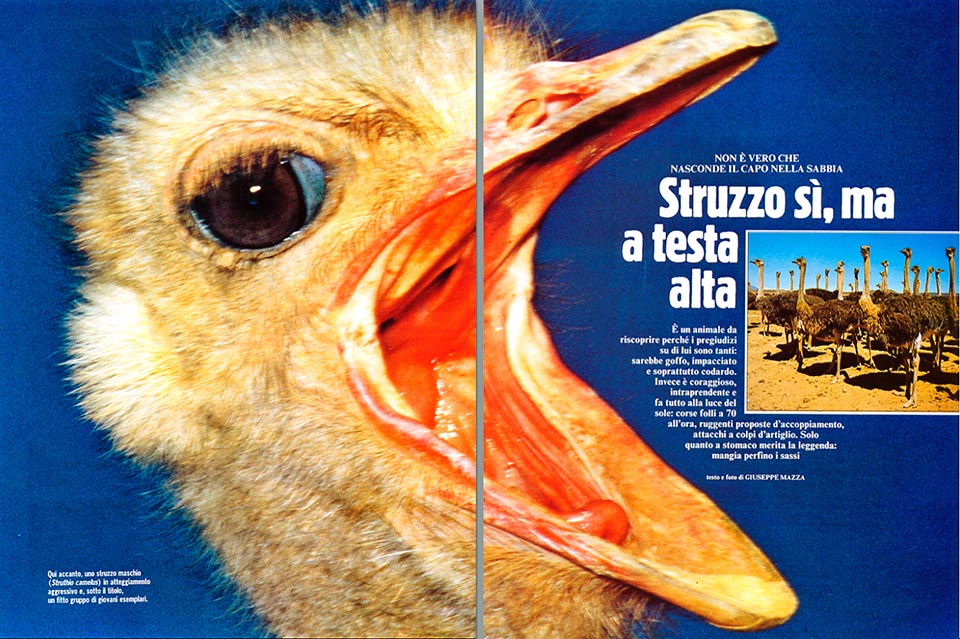
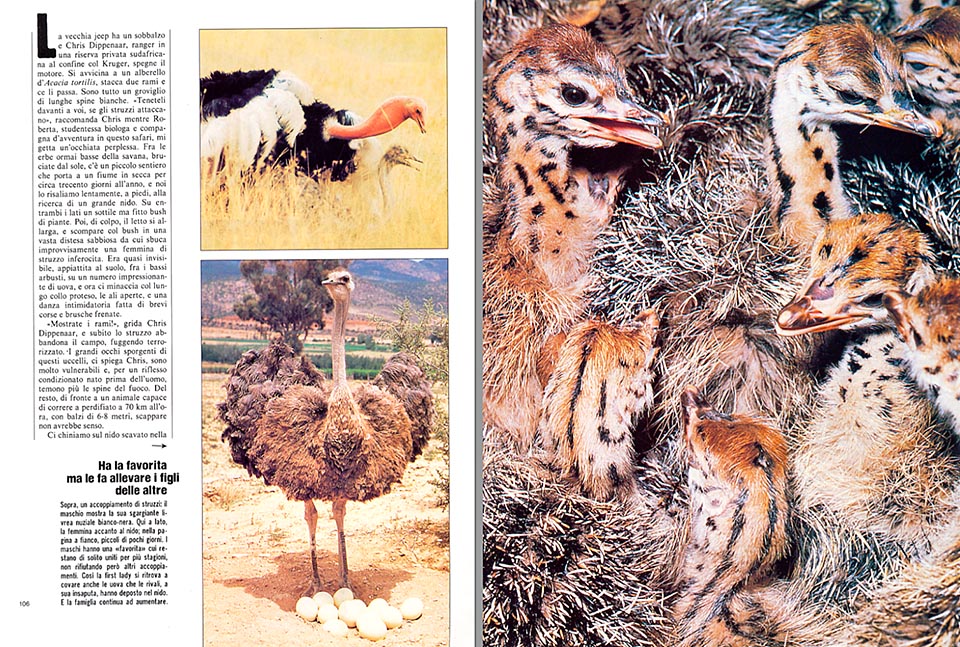
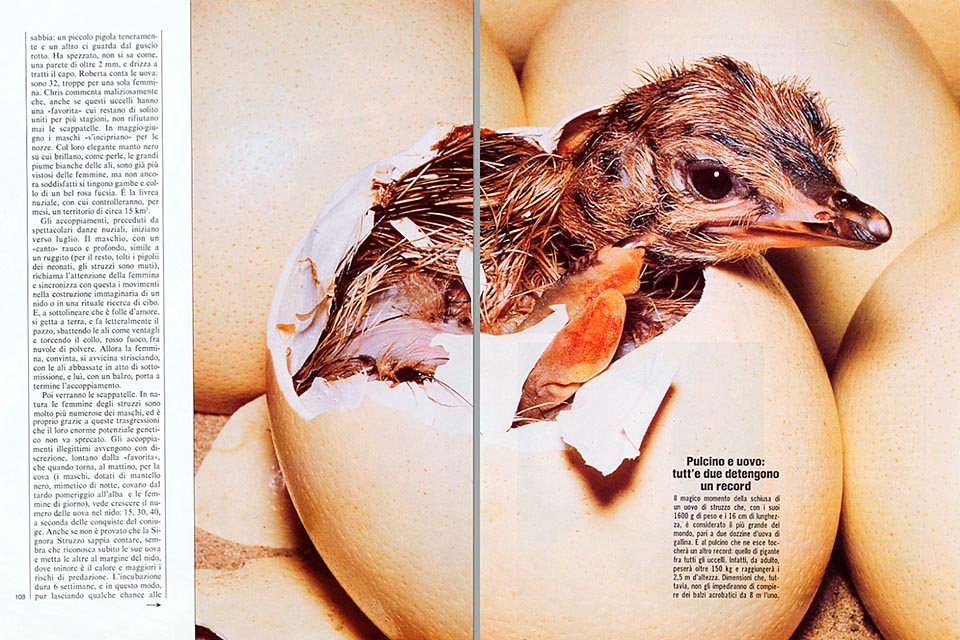
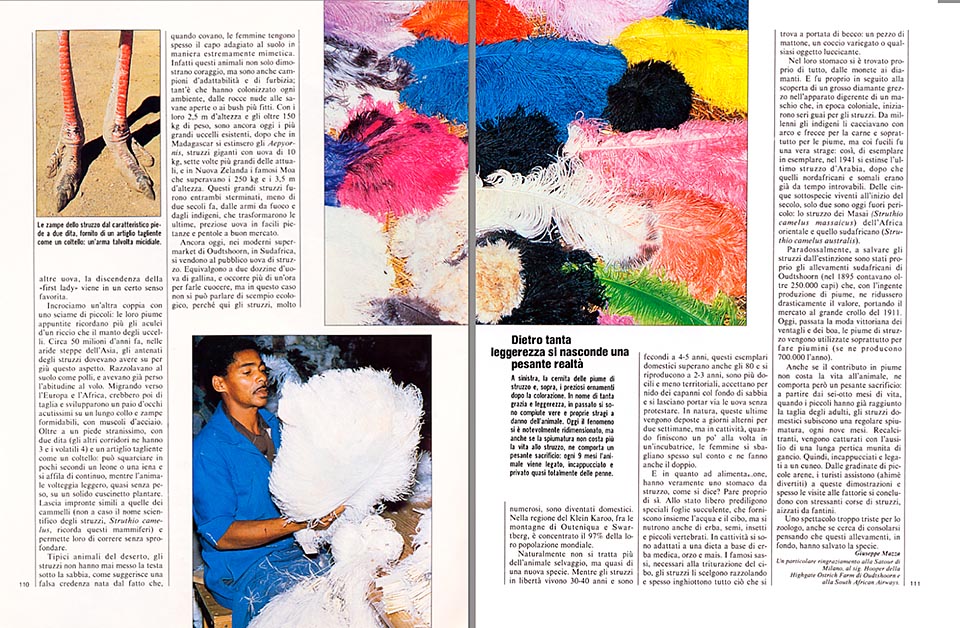
![]()
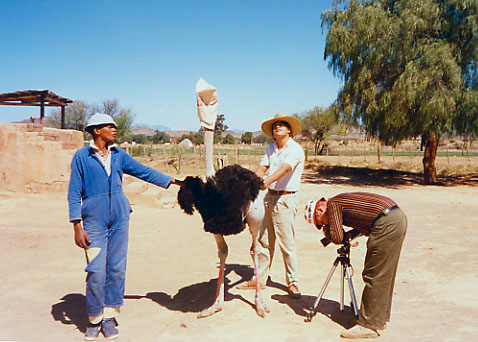
How to photograph safely the feet of an ostrich

Texto © Giuseppe Mazza

English translation by Mario Beltramini
The old jeep jumps, and Chris Dippenaar, ranger in a private reserve at the boundary with the Kruger, switches off the engine.
He approaches a small tree of Acacia tortilis, pulls off two branches, and gives them to us with professionalism. Rather than branches, really, it’s a tangle of long white thorns, which reduce drastically the transpiration of this xerophilous species, and allow it to stay months and months without water, tranquilly defying the heat and the appetite of even the most hungry goat.
“Keep them in front of you, in case they attack”, adds with a gesture, while Roberta, student in biology, and companion of adventure in the safari to the ostrich, casts a glance to me, puzzled.
Between the grass, now short and burnt by the sun, of the savanna, there is a small path leading to a river which is dry 300 days per year, and we go up, on foot, looking for a big nest. On both sides, a thin but thick bush of plants with very long roots, chase the water in depth; cool shelter for leopards and lions, which perhaps are looking at us, while our guide, a Westley-Richards 404 gun in hand, at his turn, is looking at the small green extent.
Then, suddenly, the river spreads off, disappears with the bush in a wide, sandy extension from which, almost to confirm a false imagine of the ostrich, appreciated by trade-unionists and politicians, suddenly emerges, from the nothing, an angry female.
It was almost invisible, stretched on the ground, between the low bushes, over a striking quantity of eggs, and now threatens us, with the long neck stretched out, the wings wide open, and a frightful dance, with short runs and sudden stops.
“Display the branches”, Chris Dippenaar cries, and, immediately, the ostrich abandons the field, and runs away, terrorized, like a witch confronted with a small bunch of garlic.
“The large protruding eyes of these birds”, he explains to us, ” are very vulnerable, and, for a conditioned reflex action, born before the mankind, they fear for the thorns more than the fire”.
Besides, with an animal able to run at 70 km per hour, with 6-8 metres jumps, running away would be a nonsense; better, if a suitable branch is not available, to lie down on the ground, in such a way that the deadly nail of its foot cannot hit with violence.
We bend on the nest digged in the sand: a young chirps tenderly, and another one looks at us from a broken shell.
It has broken, we don’t know how, a shell thick more than two millimetres, and raises, now and again, the head. Roberta counts the eggs: they are 32, too many for one female, and while we diplomatically withdraw, followed by an aggressive male, arrived to help, Chris comments, maliciously, that even if these birds have a “favourite” female, to which they remain faithful for several seasons, they never refuse escapades.
In May-June, the males powder themselves for the wedding. With their elegant black mantle, on which sparkle, like pearls, the great white feathers of the wings, they are already more showy than the females, but, not yet satisfied, they dye legs and neck with a nice fuchsia-pink colour. It’s the bridal livery, with which they will control, for months, a territory of about 15 square kilometres, signal of green light for the wedding, and of danger for the rivals.
The pairings, preceded by spectacular nuptial dances, begin by July, at the end of the austral wintertime. The male, with a “song” hoarse and profound, similar to a roar (on the other hand, apart the chirping of the new-born, ostrich are dumb), attracts the attention of the female, and synchronizes with this one the movements in the imaginary construction of a nest, or in a ritual research of food.
“We shall be united for the young”, repeats with the movements, “my house will be yours, my food will be yours, and we shall always look for it, together, between the grass of the savanna”.
And in order to underline that it’s crazy of love, when sees that the betrothed girl agrees, it drops down to the ground, and acts literally like a mad, flapping the wings, fan-like, twisting the neck, fiery red, between clouds of dust. The female, convinced, gets then closer, crawling, with the wings lowered, in a posture of submission, and the male, with a jump, realizes the mating.
Later on, escapades will happen. In nature, the females of ostrich are much more numerous than the males, and it’s just thanks to these transgressions, that the enormous genetic potential is not wasted. The illegitimate couplings happen discreetly, far away from the “favourite”, which, when back in the morning for sitting (males, stronger, and mimetic the night, due to the black mantle, brood from late afternoon to the daybreak, and females during the day), sees then, strangely, the number of eggs in the nest increasing: 15, 30, and even 40, depending on the conquests done by the consort.
What makes them accepting rivals, still remains a mystery, but even if it is not proved that Mrs. Ostrich is able to count, it seems that she recognizes at once her eggs, and puts the others on the borders of the nest, where heat is less and greater are the risks of being preyed. The incubation lasts, in fact, 6 weeks, and, in this way, even if leaving some “chance” to the others, her descendants are somewhat favoured.
We cross another couple with a crowd of young. They are no more than 2-3 weeks old, and their pointed plumes call to mind more the hair of a hedgehog, rather than the mantle of the birds.
About 50 millions of years ago, in the arid steppe of Asia, the ancestors of the ostrich had more or less this look. They were scratching on the soil like fowls, and had already lost, even if not the inclination, the habit of flying.
While migrating towards Europe and Africa, they increased of size, maybe for running away faster, maybe for defence against predators, and developed a pair of very acute eyes, on a long neck, dreadful legs, with steel muscles, and a very odd foot, with two fingers (the other corridors do have 3, and birds 4, of them), and a clutch as sharp as a knife. It can tear a lion or a hyena in a few seconds, and gets sharpened continuously,
while the animal whirls, lightly, almost without any weight, on a solid palmar small cushion.
It leaves traces similar to those of camels (in fact, the scientific name of ostrich, Struthio camelus, clearly recalls these mammals), and permits them to run, without sinking, even in the most friable soils. Typical desert animals, ostrich have never put the head under the sand.
Even if, compared to the body, this looks funny and small, they are champions of adaptability and cunningness; in fact, they have colonized every habitat, from the bare rocks, to the open savannas or the thickest bushes, with survival strategies and behaviours always new, which render puzzled the ethologists, in any case with their height of 2.5 metres, and a weight of more than 150 kg, they are, still now, the biggest existing birds, after that in Madagascar, the Aepyornis, gigantic ostrich with 10 kg eggs, seven times bigger than the present ones, and in New Zealand, the famous Moas; which were weighing more than 250 kg and were more than 3.5 metres high, did extinguish. Practically, they had no enemies, but both were exterminated, less than two centuries ago, by the firearms and by the natives, which did transform their last precious eggs in easy dishes of food and in cheap cauldrons.
Still nowadays, in the modern supermarkets of Oudtshoorn, in South Africa, they sell ostrich eggs, for big omelettes on “family size” boiled dinners.
They correspond to two dozens of eggs of hen, and one needs more than one hour to get them hard-boiled, but this is not an ecological havoc, because here ostrich have been tamed, gigantic battery fowls.
“In the region of Klein Karoo, between the mountains of Outeniqua and Swartberg”, Mr. Coetzee, Manager of a co-operative with 350 breeders, confirms to me, “It’s concentrated the 97% of their world population. It’s not any more a wild animal, but almost a new species, outcome of long selections.
Ostrich, in liberty, lives 30-40 years, and is fecund when 4-5 years old, these ones reach also the 80, and reproduce when only 2-3 years old. They are much more tractable and less territorial, like all tame forms. They accept as nest, huts with the ground of sand, and permit to take away their eggs without remonstrance. In nature, females lay them, by alternate days, for two weeks, but under captivity, when they slowly go to the incubator, they mistake in counting, and even double the production.
Nature has furnished them, by the time of their birth, of more than 2.000 eggs cells, and if the food is abundant, theoretically, they might lay all of them.
“Feeding”, Mr. Coetze explains, “has been the first big problem to resolve in the breeding. Even if they eat, as delicacies, insects, lizards, mice, and even snakes, ostrich are essentially herbivorous, but, unlike oxen and sheep, they refuse hay.
Their preferred course, in nature, is formed of special succulent leaves, which provide, at the same time, water and food, plants which grow up by themselves also in the enclosures of Klein Karoo, but which certainly are not sufficient to the present 90.000 heads.We have, therefore, adapted them to a diet based on alfalfa, barley and maize. Each bird eats about 5 kg of this per day, and we have then to integrate these vegetables with dough of bones, and shells of eggs, for a balanced contribution of calcium.
The famous stones, necessary for grinding the food, are chosen by the ostrich themselves, by scratching. They are attracted by all which glitters, and in their stomach, we can find really everything, from coins to hairpins.
The big troubles for the ostrich began, rightly, in colonial times, with the discovery, in the stomach of a male, a big, raw, diamond. Since millennia, natives were hunting them with bow and arrows, for the flesh and, mainly, for the feathers, valued, since the old times, for their perfect symmetry, emblem of justice.
but, with the guns, it was a true slaughter. Even if they had to be satisfied with some feathers and a roasted haunch, all hoped to find a diamond, and in 1940, the last Arabian Ostrich died, well after that those from North Africa and Somalia had disappeared since long time.
Of the five sub-species living at the beginning of this century, two only are nowadays out of danger: the Masai Ostrich (Struthio camelus massaicus), of East Africa, and the South African one, the Southern Ostrich (Struthio camelus australis).
Indeed, they have been saved by the breeding of Oudtshoorn (in 1895 they counted more than 250.000 specimens), which brought the market of the feathers to the great collapse of 1911.
Nowadays, the production is stable, with about 125 Tons per year, but, passed away the Victorian fashion of the fans and the boas, the training sector is that of the feather dusters.
They are produced and sold by the supermarkets of the whole world at the incredible rhythm of 700.000 per year.
After the 6-8 months of life, when the young have already reached the size of the adults, tame ostrich are plucked on a regular basis, every 9 months. Recalcitrant, at the top of a long pole provided with a hook, they are immobilized, muffled, and tied to a wedge, for the shearing.
From the staircases of small amphitheatres, tourists assist, amused, to these demonstrations, and funny races of ostrich, with jockeys, conclude the visits to the farms. A sight probably sad for a zoologist, but it is also true that these breeding have saved the species.
SCIENZA & VITA NUOVA + NATURA OGGI – 1989
